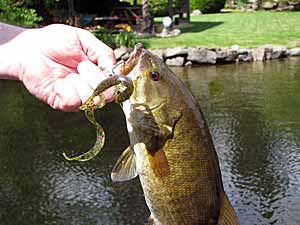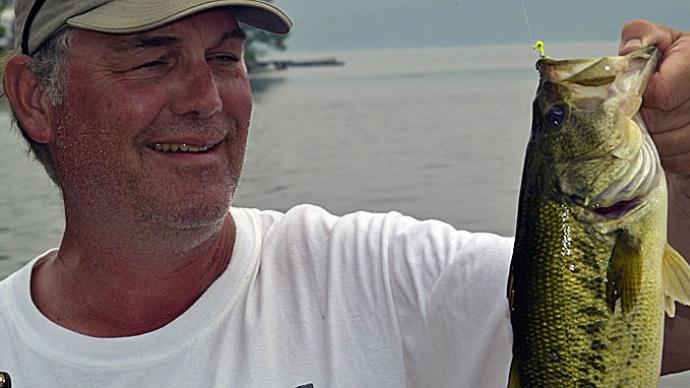
How do I rig a Texas-rigged worm? The way to rig a Texas rig is to insert the hook into the plastic and run it into the worm about 1/4 inch. Then, pull the hook to the eye, turn it around, run the hook tip through the worm, and then skin hook it on the opposite side so that the rig is weedless. Ensure the worm hangs straight, or it will twist your line. Now, you're ready to start fishing.
The next question will be: how do I know when I get a bite? First, let us look at how a bass bites a plastic worm. As a rule, bass will see the worm moving along the bottom and approach from the front or back of the worm and simply open their mouth. This sucks the worm into their mouth. The bass can blow the worm out quickly if it does not feel or taste right. It is felt as a "tap" or "thump" in the rod or line.
Pick up your rod and reel with a Texas-rigged worm and throw it out. Have a friend hold the line tight or put a little tension on the line. Now, have your friend flick the line with their finger lightly. This is the "tap" or "thump".
You must be in contact with the line and train yourself to be a line watcher to detect strikes. Sometimes, you may not feel the strike at the rod, but if you are a line watcher, you will see the line stop, move sideways, or "twitch," which indicates a strike. It is particularly effective for the hit while the worm is falling. You must have that contact and visualization to detect strikes. Keep the slack out of your line. An old trick invented many years ago was to put a free-sliding small cork on the line and watch the cork for strikes until you become familiar with the "feel" of a strike. Other types of strikes:
- Sometimes, as the worm falls to the bottom, the bass inhales it before it hits the bottom. This strike is hard to detect. When you pick up the slack, the worm feels mushy, heavy, or like it has pressure on it. Do not hesitate. Set the hook.
- Sometimes, when you cast the worm, and it settles to the bottom, a bass picks it up and swims off before you can get the slack out of your line. This scenario is perfect for line watchers because the minute you see the line move set the hook.
- There is one more strike that is very difficult to describe and detect. You are fishing grass or moss flats. You cast your worm out and allow it to go to the bottom. When you pick up the slack, it feels hooked on a piece of grass or moss, so you keep it tight for a few seconds. Suddenly, you feel that tap and set the hook - nothing there. The tap you just felt was the bass spitting out the worm. Any time it feels heavy or hung on grass when you retrieve your slack, set the hook. It does not cost anything, and it could be a fish.
That brings up the question: How do I set the hook? Set the hook as soon as you feel the bite or think you have a fish. Reel down to the 3:00 position and then set the hook with a lot of force. Do not wait or count to three. At the first tap, set the hook. A hard, forceful hook set is required. The best description is to "Try and cross his eyes." When a fish eats a plastic worm, the bass balls it up in its mouth, and you may have to penetrate the worm a few times before you hit the lip. If you think you did not get a good enough set on your first one, set the hook again, but do not give the fish any slack in the line.
Techniques
Let's say you come along a bank that has several stumps in or under the water but are visible. A perfect technique for this situation is flipping. This close-quarters fishing technique allows you to underhand cast to a pinpoint area. A fixed length of line is reeled off and held in one hand while the other holds the rod. Use a Texas rigged bait with heavy-duty 14- to 30-pound test line and a heavy action 7 or 7 1/2 foot rod. Swing the bait toward the target and release the held line. This technique is used when fishing heavy cover. With some practice, you can become adept and accurate with this technique.
When you cast a worm, it causes a big splash and noise when it hits the water. This can spook a fish from the cover. Now, when you flip a worm, the water entry does not cause a splash and virtually no noise. This situation is desirable because you will not spook fish in shallow water.
There is another technique known as pitching. When pitching, hold the bait in one hand and the rod in the other. Underhand cast, releasing the bait, allowing the reel to free spool. You need to thumb your reel if using a baitcast reel, but you can adjust the reel to stop most of the backlashes. With this technique, you can cast for more distance than flipping and get the quiet entry after some practice.
Avoid making long casts unless you are using braided line. All monofilament line has some degree of stretch. An extra-long cast with monofilament line allows enough stretch when setting the hook that you may not get good hook penetration.
Some fishermen use fluorocarbon line in clear water. The purpose of this is the fact that this line can disappear in the water. This line does not have as much memory or stretch as regular monofilament; thus, it is better for long casts. It also boasts a 20% higher tensile strength and excellent abrasion resistance at the same diameter as monofilament.
When casting your worm, look for some cover - a log, a bush in the water, the edge of a moss bed, lily pads, rocks, or any type of cover a bass can hide in. Cast a couple of feet past your target and work the worm through the cover with a pumping motion. Hold your rod at 3:00 until the worm settles on the bottom. Raise the rod to 1:00, reel in the slack line, and allow the worm to sit briefly. Drop the rod back to the 3:00 position and retrieve the slack.
Vary the time between "jigging" the worm until the fish tell you which retrieve works best. The biggest mistake most people make is to fish a worm too fast.
Another method for fishing Texas rigged baits is swimming it. In some situations, "swimming" a Texas-rigged bait, works exceptionally well. The first situation is a moss bed. The moss must be something like coon tail moss for this to work correctly. First, you put a 1/16 or a 1/8 ounce weight on the rig. Cast the worm out and allow it to settle onto the moss. Start reeling the worm slowly, just "ticking" the moss. If it is a shallow moss bed and you can see the worm, slowly reel it until you reach a hole in it. Allow the worm to settle into the hole. If nothing strikes the bait, continue reeling until the next hole and repeat. This technique can produce some impressive bass at times.
The second situation concerns boat docks. These structures are like bass magnets. There are always fish around boat docks. If you fished around the dock and did not get any strikes, try casting the worm into the dock and allowing it to sink just below the floatation of the dock. When it has sunk approximately three or 4 feet, slowly reel the worm back to you. Hang on because strikes at this point can be arm-shattering.
Speaking of boat docks, check the dock for rod holders. Note the direction they are pointing. You should discover a submerged brush pile at a comfortable casting distance from the rod holders. On sunny days, this brush pile holds fish. My partner and I fished a US Bass Buddy tournament on Lake Hamilton in Hot Springs 1985. Just looking at Lake Hamilton, it is devoid of visible cover. We fished for several hours with no success whatsoever. We began fishing a row of boat docks. On the third boat dock, we noticed several rod holders across the front of the dock. We cast to the dock and began our retrieves. We felt a brush pile, and we immediately got a bite. We concentrated on docks with rod holders and began consistently catching fish. We did not win the tournament but placed third and received a very nice check. Keep boat docks in mind when they are available.

The basis for this article is the professional bass fishing career of Carlton "Doc" Holliday. I made many mistakes and point them out in this book. I intend to help you become a better worm fisherman in less time without my mistakes. I have also inserted some helpful tips to make your experience easier.
Carlton "Doc" Holliday has won over 30 bass tournaments, individually and as a team member with his wife, and placed in the top 5 in over 70 bass tournaments. The last three years of his career as a professional bass fisherman were spent winning the Arkansas Guys and Gals Championship with his wife in 1991, finishing seventh overall in the Arkie Division of the Redman Circuit in 1991, and becoming eligible to fish the Redman Regional Tournament in Columbus Mississippi where he finished 20th. Also, in 1990, I fished in the Mr. Bass of Arkansas Championship on Lake Ouachita and finished third. Career winnings are estimated at over $85,000.00, but remember, bass tournaments did not pay the big bucks back then that they pay now.




